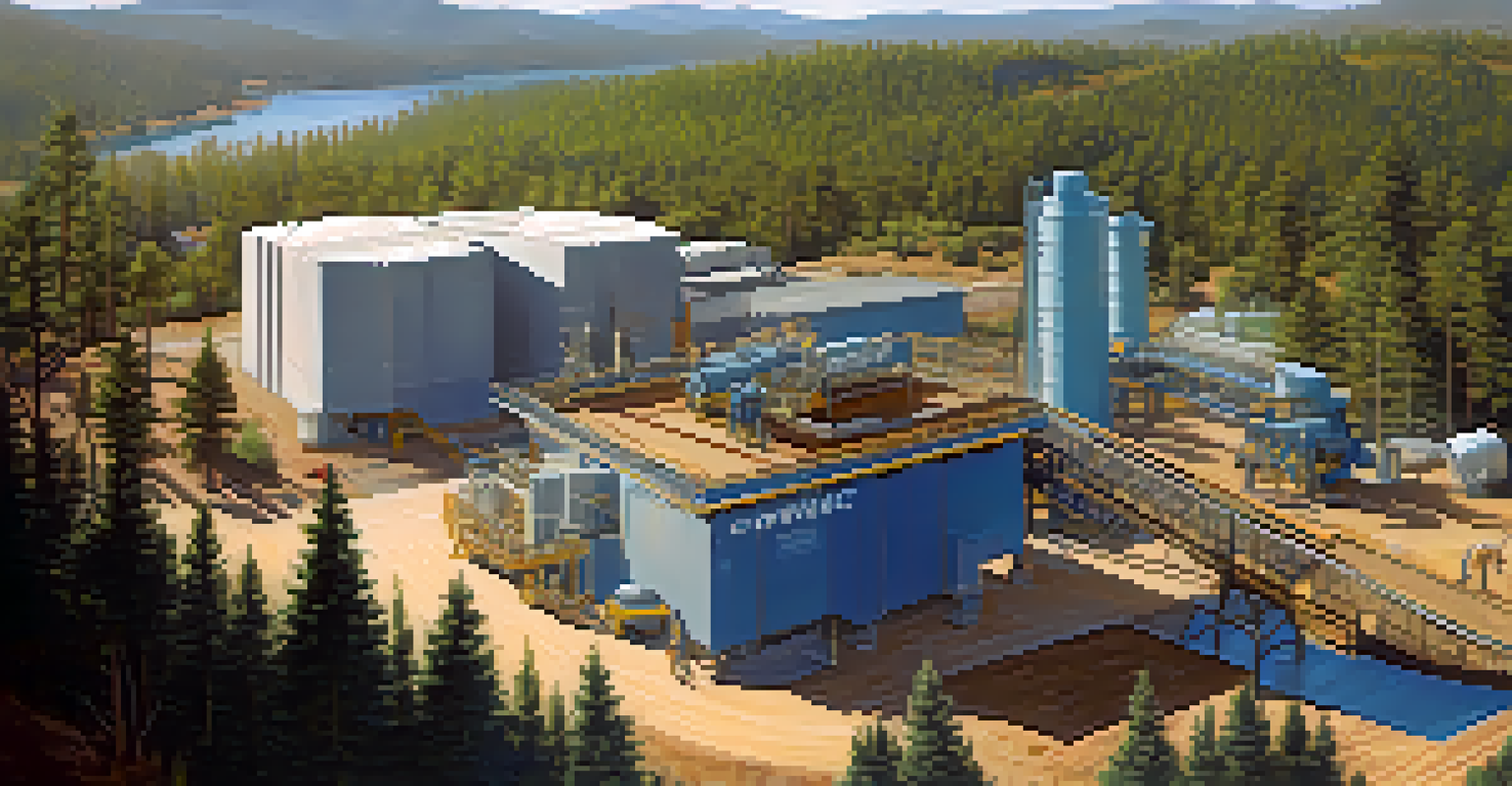Mining Techniques Used in Big Bear: Then and Now

The Early Days: Gold Rush Mining Techniques
In the mid-1800s, Big Bear became a hotspot during the California Gold Rush. Miners flocked to the area, employing simple yet effective techniques like panning and sluicing to extract gold from riverbeds. These methods required minimal equipment and relied heavily on manual labor, making them accessible to a wide range of hopeful prospectors.
Gold is where you find it.
Panning involved using a shallow pan to swirl water and sediment, allowing gold to settle at the bottom. Sluicing, on the other hand, utilized long wooden troughs to channel water over gravel, trapping heavier gold particles. These techniques were not only physically demanding but also required a keen eye for spotting potential gold deposits, showcasing the miners' ingenuity.
While these early techniques laid the groundwork for mining in Big Bear, they were often met with challenges, such as harsh weather and competition. Nevertheless, the allure of gold drove many to persevere, establishing Big Bear's reputation as a mining town.
The Rise of Hard Rock Mining
As surface gold became scarce, miners turned to hard rock mining in the late 1800s. This method involved digging tunnels into the mountains, targeting gold veins deep within the earth. Hard rock mining was a more complex and dangerous undertaking, requiring specialized equipment and skilled laborers to extract the ore safely.

Miners used tools like drills, dynamite, and hoists to break apart rock and transport the valuable ore to the surface. This shift marked a significant advancement in mining techniques, as it allowed for the extraction of larger quantities of gold, which in turn fueled the local economy. However, it also brought risks, including cave-ins and exposure to hazardous conditions.
Evolution of Mining Techniques
Mining in Big Bear has progressed from simple panning methods during the Gold Rush to advanced, sustainable practices that prioritize environmental stewardship.
The introduction of hard rock mining transformed Big Bear from a small mining camp into a bustling town, complete with hotels, saloons, and shops catering to the growing population of miners and their families.
Technological Advancements in Mining
By the early 20th century, technological advancements began to revolutionize mining techniques. Innovations such as electric drills, conveyor belts, and steam-powered machinery significantly increased efficiency and safety. These tools allowed miners to extract ore more quickly and with less manual labor, changing the landscape of mining in Big Bear.
The future belongs to those who believe in the beauty of their dreams.
For instance, the use of electric drills reduced the physical strain on miners and improved precision when drilling into rock. Additionally, conveyor belts streamlined the process of transporting ore, minimizing the time and energy spent on manual hauling. These advancements not only enhanced productivity but also contributed to safer working conditions.
However, with these advancements came new challenges, including the need for skilled operators and increased capital investment. Despite these hurdles, the mining industry in Big Bear continued to thrive, adapting to the changing times.
The Impact of World Wars on Mining
The two World Wars had a profound impact on mining operations in Big Bear, as demand for metals surged during these times. Miners shifted focus from gold to other valuable resources like copper and lead, which were crucial for wartime production. This shift required miners to adapt their techniques and equipment to meet the needs of the war effort.
During this period, the mining industry saw increased mechanization, with more emphasis on extracting metals that supported military applications. The need for efficiency led to the development of more advanced mining techniques, including mechanized drilling and ore processing. Miners became adept at utilizing available technology to maximize output.
Community Impact of Mining
The mining industry has significantly shaped Big Bear's economy and community, fostering growth and cultural heritage while providing employment opportunities.
Post-war, as the demand for metals declined, many mines in Big Bear faced closure. However, the innovations developed during the war years set the stage for future mining operations, highlighting the industry's resilience and ability to adapt to changing circumstances.
Modern Mining Techniques: A Sustainable Approach
Today, mining in Big Bear has evolved to prioritize sustainability and environmental stewardship. Modern techniques focus on minimizing ecological impact while maximizing resource extraction efficiency. This shift reflects a growing awareness of the need to protect natural resources for future generations.
Techniques such as selective mining and advanced geological surveys allow miners to target only the most valuable ore deposits, reducing waste. Additionally, the use of eco-friendly technologies, like water recycling systems and renewable energy sources, minimizes the carbon footprint of mining operations. These practices not only help preserve the environment but also enhance the community's quality of life.
Moreover, local regulations now require mining companies to engage in reclamation efforts, restoring mined land to its natural state after operations cease. This commitment to sustainability ensures that Big Bear's mining legacy continues while respecting the beauty of the surrounding landscape.
Community and Economic Impact of Mining
Mining has played a pivotal role in shaping Big Bear’s community and economy. From the early days of gold rushes to modern sustainable practices, the industry has provided employment and fostered growth in the region. Local businesses, schools, and infrastructure have all benefitted from the economic activity generated by mining.
As mining techniques evolved, so did the community. Families settled in Big Bear, drawn by the promise of work and opportunities. The influx of miners led to the establishment of schools, churches, and local governance, creating a vibrant community. Festivals and events celebrating mining history became part of Big Bear's cultural fabric, connecting residents to their heritage.
Future Challenges and Opportunities
As the mining industry evolves, it faces environmental challenges but also opportunities through technological advancements and a focus on sustainability.
Today, while the scale of mining may have diminished, its legacy endures. The community continues to celebrate its mining history, and many residents remain connected to the industry through tourism and education, ensuring that the story of Big Bear’s mining past is never forgotten.
Future of Mining in Big Bear: Challenges and Opportunities
As we look to the future, mining in Big Bear faces both challenges and opportunities. The industry must navigate a landscape marked by environmental concerns, regulatory changes, and fluctuating market demands. However, advancements in technology and a growing focus on sustainability present opportunities for innovation.
For instance, the rise of green mining technologies could lead to more efficient operations that align with environmental goals. Additionally, local initiatives promoting responsible mining practices may attract investment and support from environmentally conscious consumers. These developments could position Big Bear as a leader in sustainable mining practices.

Ultimately, the future of mining in Big Bear will depend on the community's ability to adapt to changing conditions while honoring its rich history. By embracing innovation and prioritizing sustainability, Big Bear can continue to thrive as a mining hub for years to come.